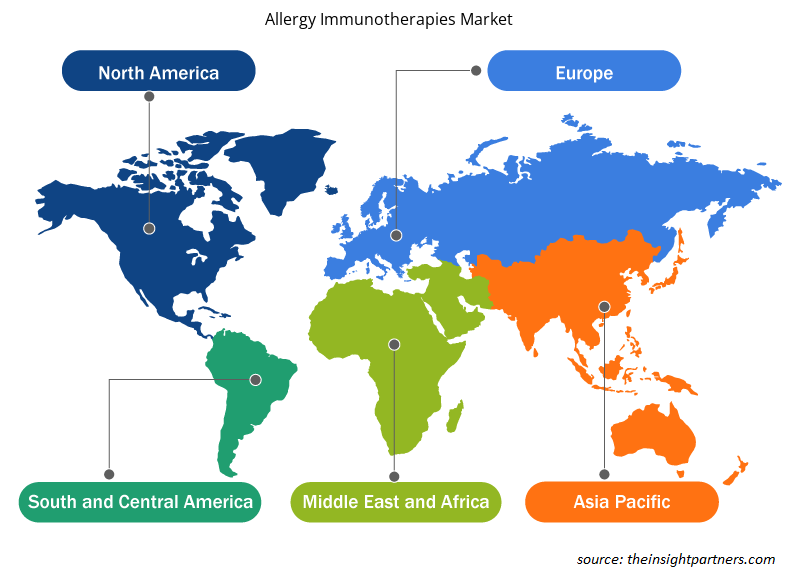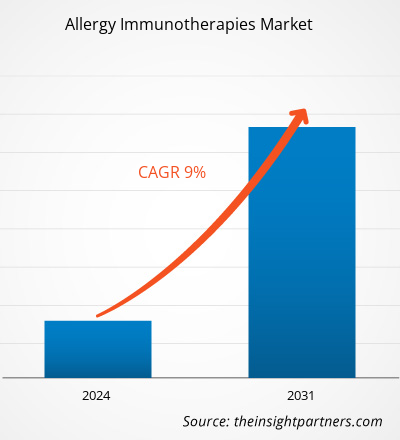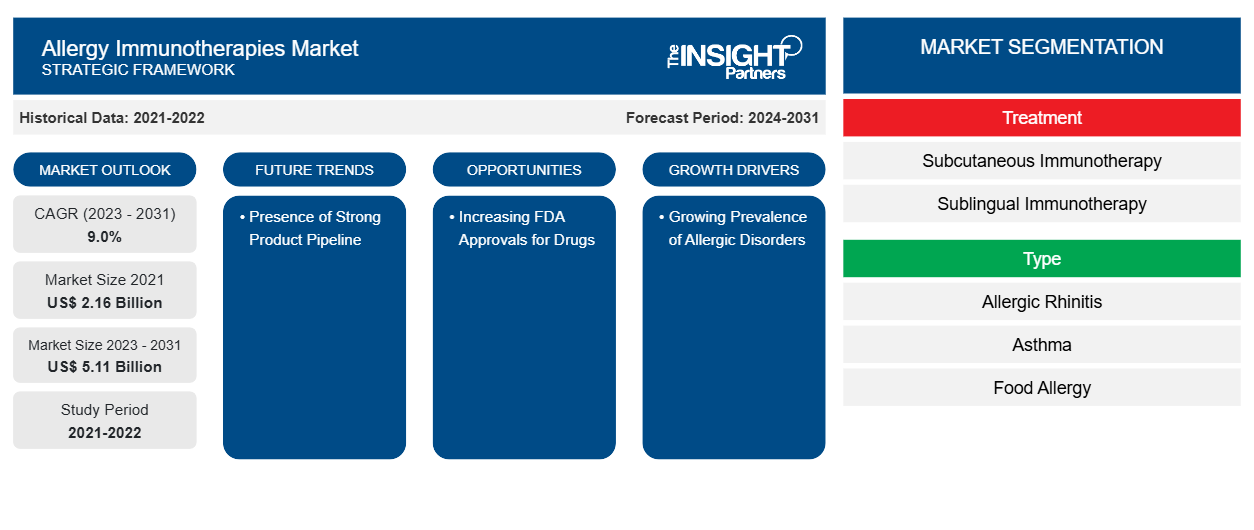过敏免疫疗法市场规模预计在 2021 年为 21.6亿美元,在 2023 年为 xx 亿美元。预计到 2031 年将达到 51.1亿美元,到 2031 年的复合年增长率为 9.0%。新给药方法的开发、联合疗法的兴起、个性化医疗的进步可能仍将是过敏免疫疗法市场的主要趋势。
过敏免疫疗法市场分析
全球范围内过敏性疾病的患病率不断上升,预计将推动过敏免疫疗法市场的增长。过敏性疾病的患病率不断上升,需要过敏免疫疗法,这是一种安全有效的治疗方法,可针对昆虫霉菌、花粉和动物等过敏原以及过敏性哮喘。根据美国过敏、哮喘和免疫学学院的数据,2021 年,美国三分之一的成年人和四分之一以上的儿童报告患有季节性过敏、湿疹或食物过敏。
全球范围内过敏症的日益流行增加了全球对免疫疗法的需求,这有利于市场的增长。
过敏 免疫疗法市场概览
全球过敏免疫疗法市场按地区划分为北美、欧洲、亚太、中东和非洲以及南美和中美。由于过敏性疾病的患病率不断上升以及舌下剂型的技术进步等因素,预计该地区的市场将实现增长。然而,预测期内,过敏免疫疗法的使用缺陷和各地区监管差异可能会阻碍市场增长。
定制此报告以满足您的需求
您可以免费定制任何报告,包括本报告的部分内容、国家级分析、Excel 数据包,以及为初创企业和大学提供优惠和折扣
-
获取此报告的关键市场趋势。这个免费样品将包括数据分析,从市场趋势到估计和预测。
过敏 免疫疗法市场驱动因素和机遇
人们对过敏治疗认识的不断提高可能会给市场带来好处。
公众对过敏症及其治疗方案的认识不断提高,这推动了对更好治疗方法的需求。人们寻求缓解可能严重影响其生活质量的症状。
州教育总监办公室 ( OSSE ) 和健康与保健司将于 2023 年 5 月 14 日至 5 月 20 日庆祝食物过敏宣传周。该活动的重点是教育和提高对食物过敏和过敏反应的认识。
拥有强大的产品线——过敏免疫疗法市场的机会
过敏免疫疗法产品线包括 15 种处于不同临床开发阶段的疗法。参与过敏性疾病免疫疗法开发的一些参与者包括Aimmune Therapeutics Inc.、DBV Technologies SA、Genentech Inc.、ASIT biotech SA、Inmunotek SL、Anergis S.A.、Biomay AG 和Regeneron Pharmaceuticals Inc.
正在进行临床试验的各种免疫疗法的积极临床结果支持了过敏免疫疗法药物的开发。例如,2022 年 11 月,美国食品药品监督管理局 (FDA) 授予Alladapt Immunotherapeutic 公司的ADP101 快速通道资格,这是一种用于治疗一种或多种最主要的食物过敏原的试验性口服免疫疗法
过敏免疫疗法市场报告细分分析
有助于过敏免疫疗法市场分析的关键部分是服务和应用。
- 根据治疗方法,过敏免疫疗法市场分为皮下免疫疗法 (SCIT) 和舌下免疫疗法 (SLIT)。2023 年,皮下免疫疗法 (SCIT) 部分占据了最大的市场份额。此外,舌下免疫疗法 (SLIT) 部分预计将在预测期内以最快的速度增长。
- 根据过敏类型,过敏免疫疗法市场分为过敏性鼻炎、哮喘、食物过敏、毒液过敏等。过敏性鼻炎部分在 2023 年占据了最大的市场份额,预计同一部分在预测期内将在市场上实现最高的复合年增长率。
- 过敏免疫疗法市场按分销渠道细分为医院药房、零售药房和在线药房。2023 年,医院药房设置部分按分销渠道占据了最大的市场份额。此外,预计同一细分市场在预测期内增长最快。
过敏免疫疗法市场份额(按地区)分析
过敏免疫疗法市场报告的地理范围主要分为五个地区:北美、亚太、欧洲、中东和非洲、南美/南美和中美。
北美包括美国、加拿大和墨西哥。北美在过敏免疫疗法市场占有最大份额,其中美国占有最大市场份额,其次是加拿大。由于过敏性疾病的患病率不断上升,美国在过敏免疫疗法市场占有最大份额,从而增加了对过敏免疫疗法的需求并推动了市场的增长。此外,它是许多从事过敏免疫疗法制造的制造商的总部,进一步推动了该国市场的增长。此外,消费者对过敏治疗的认识不断提高,增加了北美对健康补充氧气的需求。
亚太地区预计将成为所有其他地区中增长最快的地区。由于澳大利亚、印度等国家过敏和免疫疾病的发病率高等因素,亚太地区市场的增长预计将以更快的速度增长。此外,政府在预防和治疗策略方面采取的举措越来越多,预计将为该地区提供有利可图的市场增长前景。此外,在预测期内,发展医疗保健基础设施和增加投资以促进研究活动预计将推动亚太过敏免疫疗法市场的发展。
过敏免疫疗法
过敏免疫疗法市场区域洞察
Insight Partners 的分析师已详尽解释了预测期内影响过敏免疫疗法市场的区域趋势和因素。本节还讨论了北美、欧洲、亚太地区、中东和非洲以及南美和中美洲的过敏免疫疗法市场细分和地理位置。

- 获取过敏免疫疗法市场的区域特定数据
过敏免疫疗法市场报告范围
| 报告属性 | 细节 |
|---|---|
| 2021 年市场规模 | 21.6亿美元 |
| 2031 年市场规模 | 51.1亿美元 |
| 全球复合年增长率(2023 - 2031) | 9.0% |
| 史料 | 2021-2022 |
| 预测期 | 2024-2031 |
| 涵盖的领域 |
按治疗
|
| 覆盖地区和国家 |
北美
|
| 市场领导者和主要公司简介 |
|
过敏免疫疗法市场参与者密度:了解其对业务动态的影响
过敏免疫疗法市场正在快速增长,这得益于终端用户需求的不断增长,而这些需求又源于消费者偏好的不断变化、技术进步以及对产品优势的认识不断提高等因素。随着需求的增加,企业正在扩大其产品范围,进行创新以满足消费者的需求,并利用新兴趋势,从而进一步推动市场增长。
市场参与者密度是指在特定市场或行业内运营的企业或公司的分布情况。它表明相对于给定市场空间的规模或总市场价值,有多少竞争对手(市场参与者)存在于该市场空间中。
在过敏免疫疗法市场运营的主要公司有:
- ALK-Abelló A/S
- 雀巢健康科学
- 莱蒂制药
- 斯塔勒根斯·格里尔
- HAL 过敏 BV
- 强生服务公司
免责声明:上面列出的公司没有按照任何特定顺序排列。

- 了解过敏免疫疗法市场的主要参与者概况
过敏免疫疗法市场新闻和最新发展
过敏免疫疗法市场通过收集一级和二级研究后的定性和定量数据进行评估,其中包括重要的公司出版物、协会数据和数据库。以下是过敏免疫疗法和策略市场的发展列表:
- 2020 年 8 月,雀巢健康科学收购了 Aimmune Therapeutics。Aimmune 获批的疗法 Palforzia 将扩大雀巢健康科学的产品组合,成为首个也是唯一一个获得 FDA 批准的治疗方法,有助于减少儿童对花生过敏反应的频率和严重程度。(来源:公司新闻稿)
- 2023 年 9 月,Stallergenes Greer 与雀巢健康科学达成协议,利用花生过敏口服免疫疗法 Palforzia。(来源:公司新闻稿)
过敏免疫疗法市场报告覆盖范围和交付成果
“过敏免疫疗法市场规模和预测(2021-2031)”报告对市场进行了详细分析,涵盖以下领域:
- 范围内所有主要细分市场的全球、区域和国家层面的市场规模和预测
- 市场动态,如驱动因素、限制因素和关键机遇
- 未来的主要趋势
- 详细的 PEST/波特五力分析和 SWOT 分析
- 全球和区域市场分析涵盖关键市场趋势、主要参与者、法规和最新市场发展
- 行业格局和竞争分析,涵盖市场集中度、热点图分析、知名参与者和最新发展
- 详细的公司简介
- 历史分析(2 年)、基准年、预测(7 年)及复合年增长率
- PEST和SWOT分析
- 市场规模、价值/数量 - 全球、区域、国家
- 行业和竞争格局
- Excel 数据集
近期报告
客户评价
购买理由
- 明智的决策
- 了解市场动态
- 竞争分析
- 客户洞察
- 市场预测
- 风险规避
- 战略规划
- 投资论证
- 识别新兴市场
- 优化营销策略
- 提升运营效率
- 顺应监管趋势























 获取免费样品 - 过敏免疫疗法市场
获取免费样品 - 过敏免疫疗法市场